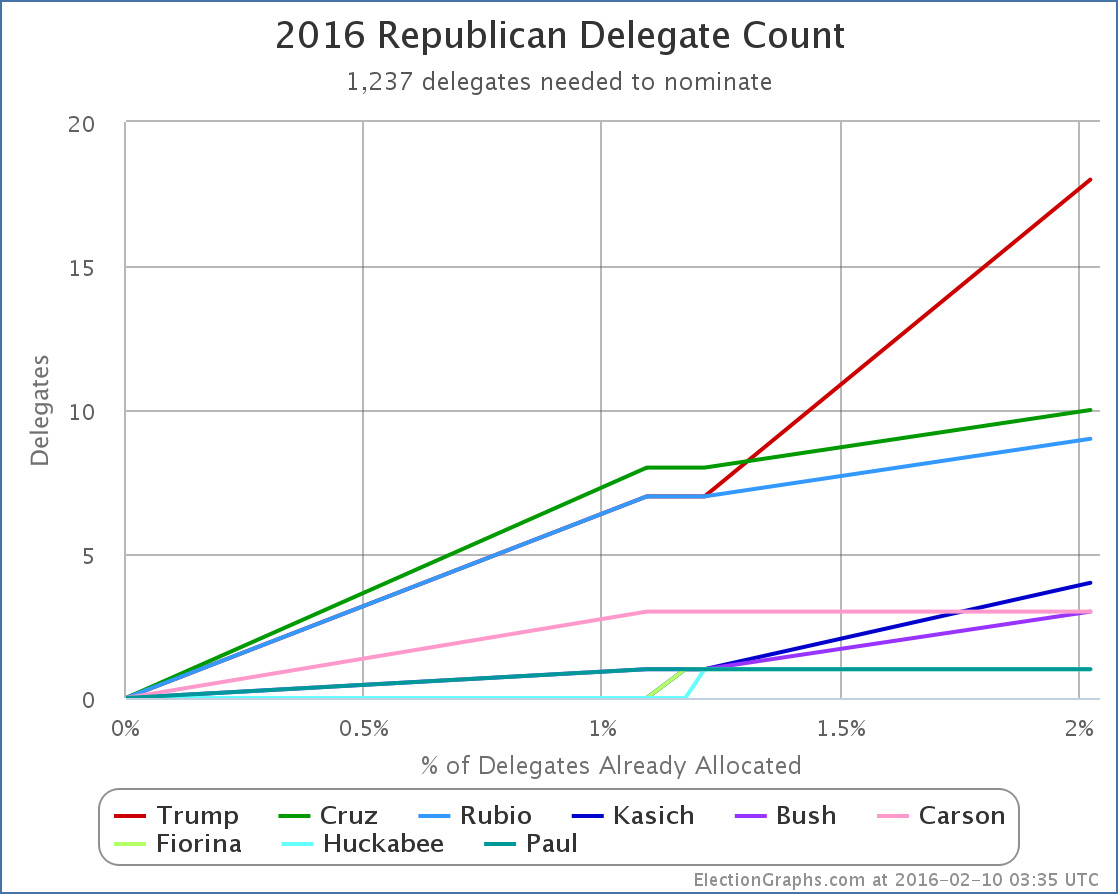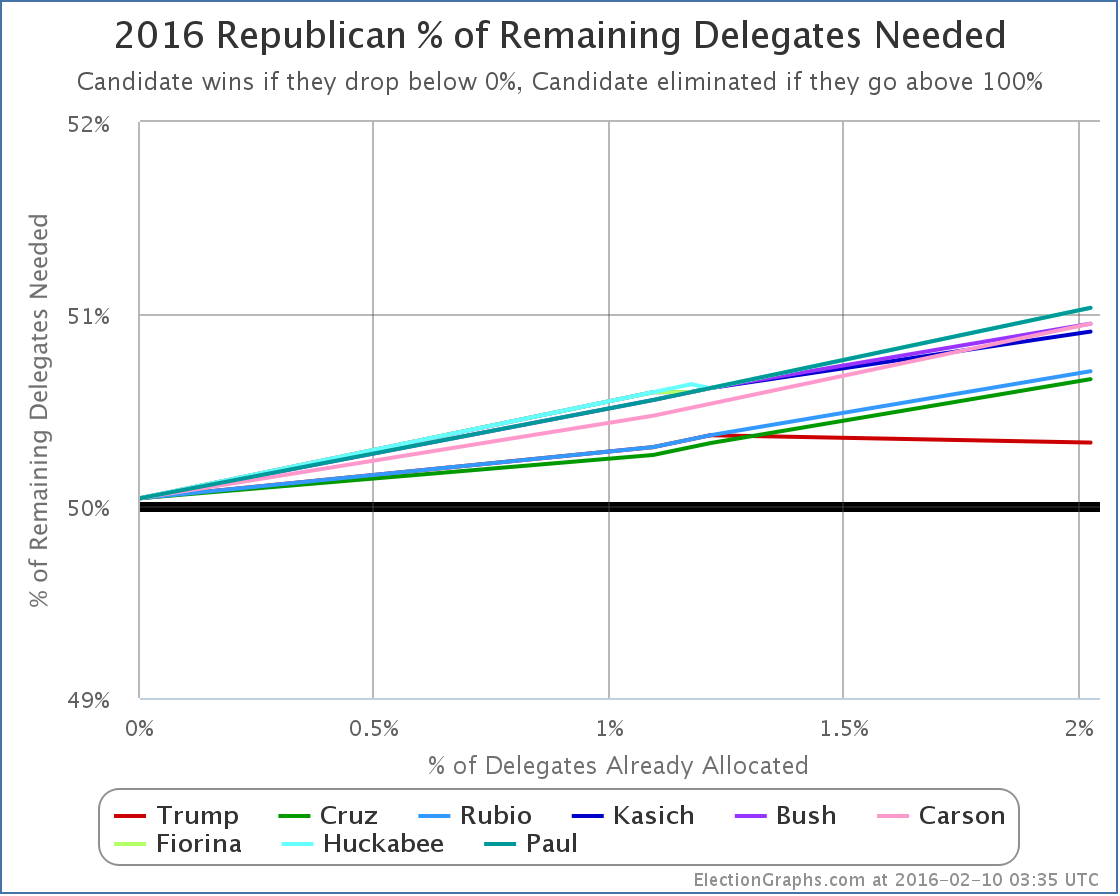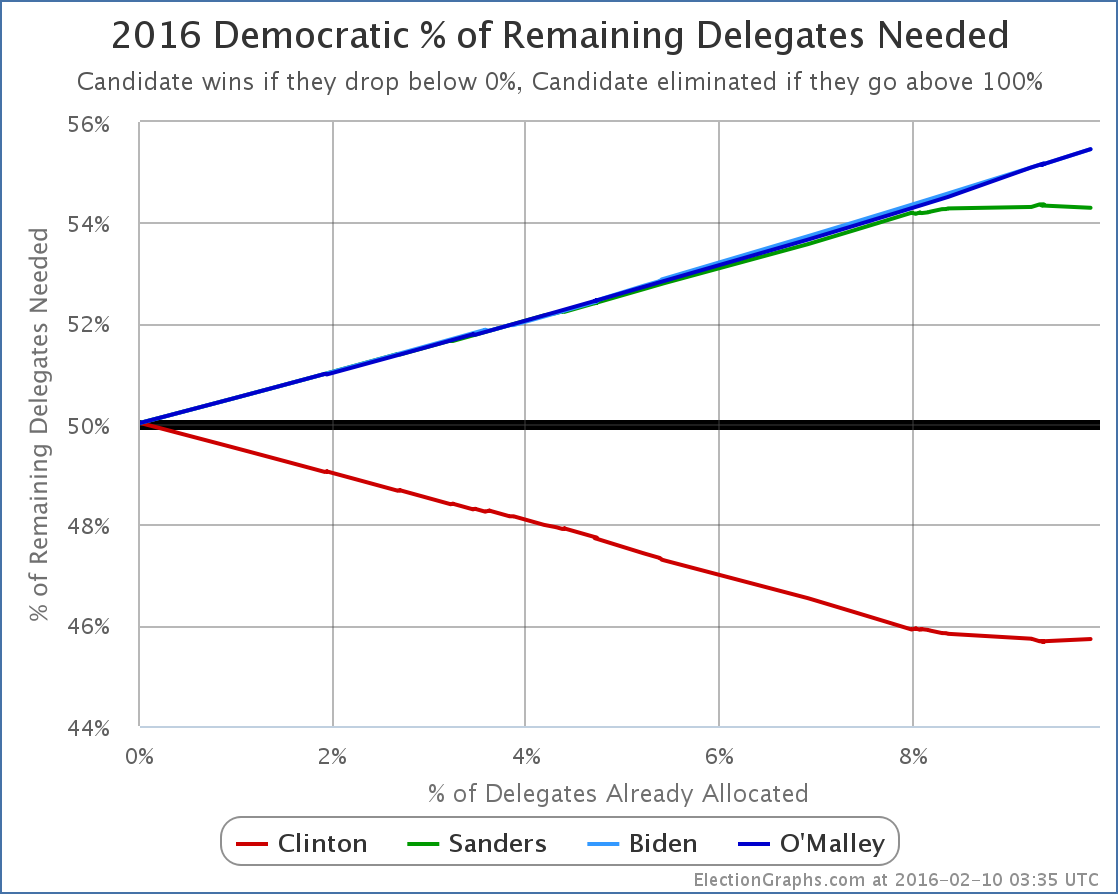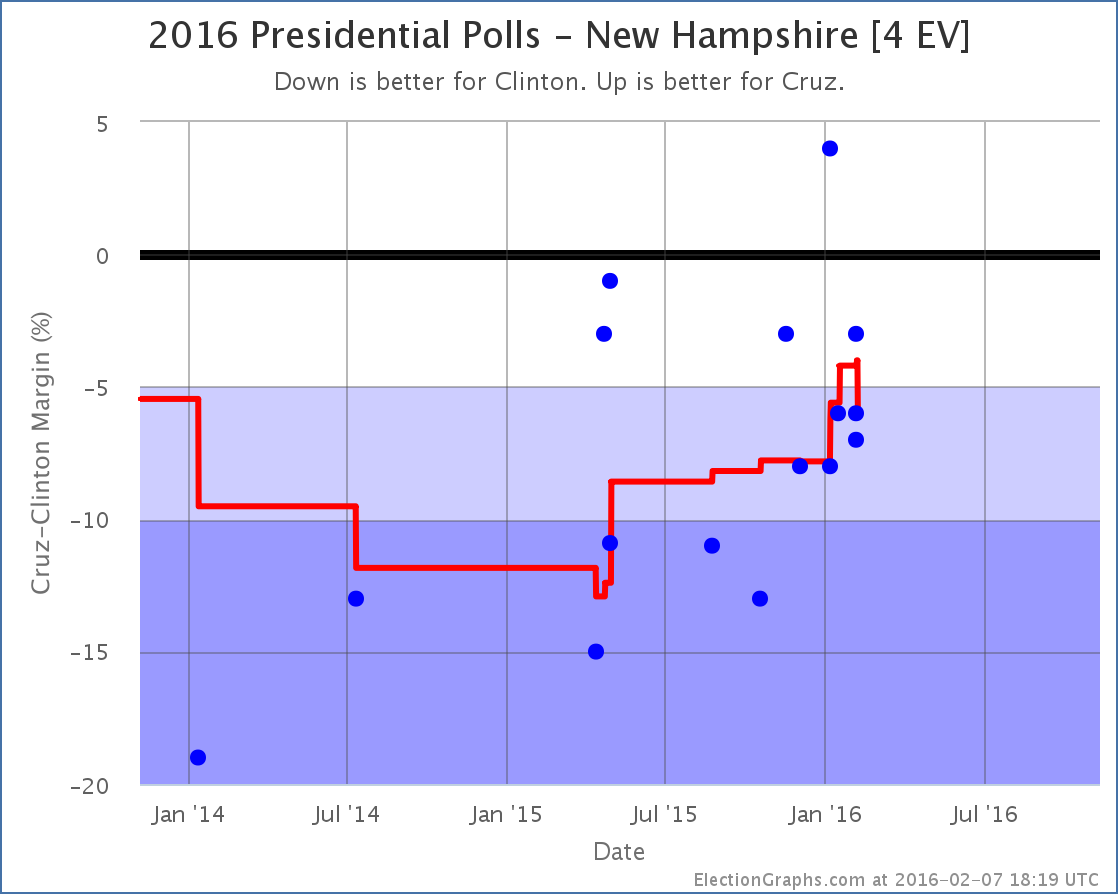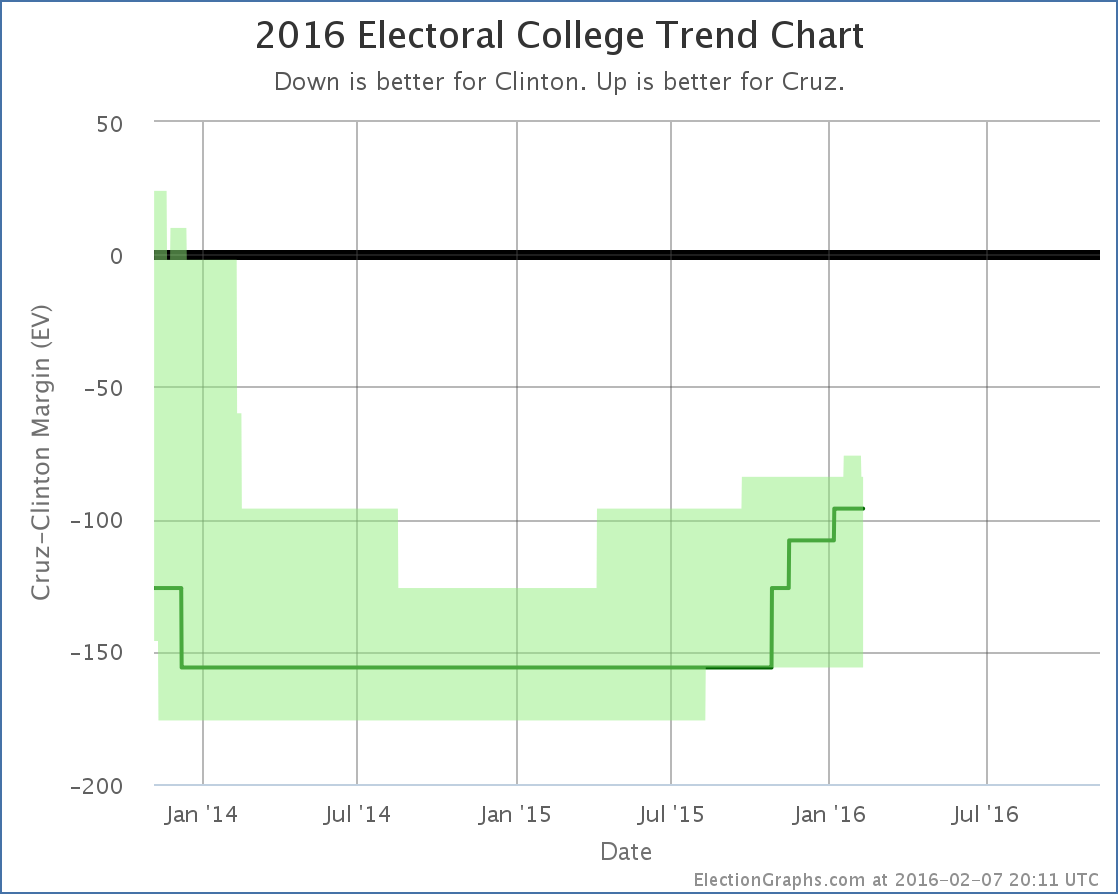- 13:48:37 [Blog post] Democrats: Sanders does what he needs to do in New Hampshire https://t.co/b6hN7qtnEe
- 16:15:06 [Blog post] Republicans: Trump takes a clear delegate lead, Cruz and Rubio still the second tier https://t.co/wPkSSdJszj
|
New Hampshire’s delegate rules are such that the winner gets a big bonus. (The details of how this works were discussed here last week.) So Trump’s approximately 36% of the vote turns into 55% of the delegates. Counting isn’t actually done yet, but if current trends hold, the delegate haul out of New Hampshire will be: Trump 11, Kasich 3, Bush 2, Cruz 2, Rubio 2. Adding these to the previous results in Iowa, and we have these new totals: Trump 18, Cruz 10, Rubio 9, Kasich 4, Bush 3, Carson 3, Fiorina 1, Huckabee 1, Paul 1. In the form of a graph of the total delegates, we see this: Some groupings look apparent on this chart. Trump is out by himself in the lead. Cruz and Rubio make up a second tier, at about half of Trump’s level. Kasich, Bush and Carson are the third tier. Way behind, but at least with multiple delegates. Then finally Fiorina, Huckabee and Paul bringing up the rear with one delegate each. Two of these three have already dropped out. It will be surprising if the third does not do so soon. How does this match what we’re hearing in the spin out of New Hampshire? Well, there is wide acknowledgment that Trump did have a nice win. But the majority of the attention still seems to have been on the race for second, and how that positions the anti-Trumps going forward. Within that, relatively little attention was paid to Cruz, and he is still in 2nd. Rubio is being dismissed because he did badly in New Hampshire, but he is still in 3rd over all. Meanwhile lots of attention given to Kasich and Bush, but they are still stuck in the third tier with Carson with less than a handful of delegates. Time to flip this and look at this in terms of my favorite metric, the “% of remaining needed to win”: Trump exceeded the 50.37% of the delegates he needed to get to improve his position. Going forward he needs 50.33% of delegates to be on a pace to win. That is a relatively small change. With almost 98% of delegates still to be determined, there is a huge amount of flexibility available here to all the candidates. Given that Trump got 55% of the delegates in New Hampshire, that means however that NONE of the other candidates got what they needed, or even close. Essentially, every one of the non-Trump candidates fell further behind today. Now, Trump still doesn’t have a majority of delegates. To be on a pace to actually win, rather than just to have the most delegates going into the convention, he needs to do better than he has so far. But he is far closer to that mark than any of the other candidates. And if he continues matching his New Hampshire results, he will win. The story here continues to be that while Trump hasn’t managed a majority in any contest so far, the opposition is so divided that Trump still easily wins (New Hampshire) or at the very least comes very close (Iowa). Does this continue? Does it get worse? Time to look at the next contest on the Republican side, South Carolina. There have not been any South Carolina polls since before Iowa, so new polls are eagerly anticipated, but at the moment the RCP average has Trump at 36.0%, Cruz at 19.7%, Rubio at 12.7%, Bush at 10.0% and then everybody else. Now, that may change. Specifically if either Rubio or Bush drop out that will scramble things a bit. But that may not happen. There is a case to be made for both of them sticking in at least through South Carolina. Trump probably wins this. But by how much? Time to look at the delegate rules in South Carolina. From Greenpapers:
If Trump wins by any margin, no matter how small, he gets 29 of the 50 delegates right up front. That already would give him 47 of the 100 delegates that would have been allocated in Iowa + New Hampshire + South Carolina. Of course, in order to win the whole state, he would have had to have won some of the congressional districts too. Probably most of them. And so far in Iowa and New Hampshire, it doesn’t seem like there has been a lot of geographic lumpiness to Trump’s support. So he may well win ALL of the congressional districts. In that case Trump would walk out of South Carolina with all 50 of the available delegates. This is very possible. In that scenario, after South Carolina, the overall delegate count would look like: Trump 68, Cruz 10, Rubio 9, Others 13 Trump would have a huge delegate lead. Even if he doesn’t win all 50, he will still have a very large delegate lead. Nevada is three days after South Carolina. It is proportional, not semi-winner-take-all like South Carolina, but the latest polls still have Trump with a nice lead in Nevada. Those polls are old and out of date, but does anybody think two straight wins would hurt Trump’s position? To “stop Trump” things have to move very quickly to a one on one with Trump vs Somebody. Maybe a three way race could do it, but might just be a recipe for a contested convention. But as long as we’re still looking at four or five candidates splitting the non-Trump vote, Trump wins. But the non-Trumps still seem to be in a locked battle with each other for that anti-Trump one on one slot. And in doing so, they just let Trump win. The race will of course consolidate further. More candidates will drop out. Some may drop out before South Carolina. But it is unclear if that will be enough to let one of the others actually win in South Carolina. Trump won New Hampshire. Trump looks like he will probably win the next two states. Things get more complicated once we get into March, but Trump would get there with a substantial lead. Things are by no means settled yet. There is a long way to go. Even after we get past both South Carolina and Nevada 94.6% of delegates will still be up for grabs. There will still be time for the non-Trumps. But if we only get consolidation down to 2 or three candidates after the March 1st contests, when 25.8% of the total delegates will be decided, the non-Trumps that are left may have a really tough uphill fight to catch up. If consolidation doesn’t happen until after March 15th, 60% of the delegates will already have been decided, and it may just be too late. (Although if several non-Trumps are still strong at that point and Trump has the lead but not a majority, we’re looking at a contested convention, and that starts getting into completely different scenarios.) But if the non-Trumps want to actually win, they have to stop fighting each other, some of them have to drop out, and they have to actually act like Trump is the frontrunner, and that their priority has to be bringing him down rather than each other. Otherwise they are done, and Trump ends up walking away with this. Note: This post is an update based on the data on ElectionGraphs.com. Election Graphs tracks both a poll based estimate of the Electoral College and a numbers based look at the Delegate Races. All of the charts and graphs seen in this post are from that site. Additional graphs, charts and raw data can be found there. All charts above are clickable to go to the current version of the detail page the chart is from, which may contain more up to date information than the snapshots on this page, which were current as of the time of this post. Follow @ElectionGraphs on Twitter or like Election Graphs on Facebook to see announcements of updates or to join the conversation. For those interested in individual general election poll updates, follow @ElecCollPolls on Twitter for all the polls as they are added. Lets jump right to it. In the last Democratic update we mentioned that to actually improve the “% of remaining needed to win” Sanders needed to get 54.36% of the delegates available in New Hampshire. That would be 14 out of 24 delegates that were available today. He got 15 out of 24, or 62.5% of yesterday’s delegates. So he did it! In addition, since my last update, there were some superdelegate changes. The net change from those was +1 Clinton, +1 Sanders. There was also a net reduction of 1 available delegate, bringing the total number of Democratic delegates down to 4,763. With all of that in place, here is the new chart for “% of remaining needed to win”: The Sanders % Needed has indeed gone down, and he made Clinton’s go up! Sanders’ % Needed specifically moved from 54.36% to… 54.30%. This was at 54.22% before Iowa. 54.30% matches where this was right after Iowa. So, Sanders did improve his situation, but only enough to undo the superdelegate changes that happened after Iowa, not enough to get back even to where he was before the voting started. Another way to look at this is to just look at New Hampshire itself. Of delegates allocated by the Primary, Sanders got 15 delegates to Clinton’s 9. But New Hampshire also has 8 superdelegates, and 6 of these had already declared for Clinton. So the actual New Hampshire total as of today is 15 Clinton, 15 Sanders, 2 TBD. So even with his big win, which was indeed a big win, Sanders actually has only pulled even in delegates in the state. Now, of course, superdelegates can change their mind. It has been said that if one candidate was clearly leading absent superdelegates, the superdelegates would not go against them, and would start to change their minds and flip to the candidate leading in non-super delegates. Maybe. It could happen. And if it does, that movement will be tracked here. Certainly no such movement has been seen yet. In the mean time, next up for the Democrats is Nevada on February 20th. Nevada often gets relatively little attention compared to South Carolina, but Nevada will actually be the next place where we see if Sanders is able to take his New Hampshire results and build anything longer term out of it. Nevada is a caucus state, so delegates won’t actually be allocated on the 20th, but there will be results that can be used to estimate convention delegates. Nevada has 43 delegates. Of those 8 are superdelegates. Clinton already has 3 superdelegates in her column, Sanders has 1. Nevada’s caucuses will determine 35 delegates. 23 will be allocated based on results in the 4 congressional districts, 12 will be allocated based on the state wide results. To once again have a result that keeps him on pace to catch up to Clinton and win, Sanders needs to get 20 of the 35 delegates available on caucus day, assuming no additional superdelegate declarations or other adjustments between now and then. At the moment, Nevada poll averages show Clinton leading 50.0% to 30.5%… but there has been no polling there since December. Expect a variety of new polls in the next week. Watch them carefully. For Sanders to be on track, these numbers have to flip… and then Sanders has to build an even larger lead. In South Carolina, a week after Nevada, Clinton is even further ahead, although again polls there are stale and new ones taken post-Iowa post-New Hampshire are eagerly awaited. Between now and Nevada, and probably between now and South Carolina, there will be almost non-stop talk about Sanders’ threat to Clinton, how Clinton is a lot weaker than expected, how vulnerable she is. A lot of this is true. To a degree. But to evaluate if Sanders is actually a threat to Clinton eventually taking the nomination, as opposed to just being a temporary speed bump in her way, Sanders has to not only take the lead in Nevada, South Carolina and beyond, but be ahead by a significant margin, not just a little bit. This is a tall order. Maybe it is possible. But if there is talk about how Sanders is “closing the gap” or “making it closer than expected” in Nevada or South Carolina, keep in mind that isn’t enough. He needs to actually win and win by a large enough margin to get more than 54.30% of the delegates to be on pace to catch up and win. Otherwise, the task in later states just becomes even harder. Note: This post is an update based on the data on ElectionGraphs.com. Election Graphs tracks both a poll based estimate of the Electoral College and a numbers based look at the Delegate Races. All of the charts and graphs seen in this post are from that site. Additional graphs, charts and raw data can be found there. All charts above are clickable to go to the current version of the detail page the chart is from, which may contain more up to date information than the snapshots on this page, which were current as of the time of this post. Follow @ElectionGraphs on Twitter or like Election Graphs on Facebook to see announcements of updates or to join the conversation. For those interested in individual general election poll updates, follow @ElecCollPolls on Twitter for all the polls as they are added.
Most attention right now continues to be on the primary races, as we are in the days between Iowa and New Hampshire, and things are still very unsettled and exciting. But there have been a handful of new general election polls. The latest change to mention is in the matchup between the delegate frontrunners in both parties. Clinton vs Cruz For a few short weeks, some favorable polls for Cruz moved New Hampshire from “Strong Clinton” to “Weak Clinton”, meaning that the poll average showed a Clinton lead of less than 5%, so we considered the state “possible” for Cruz and included it in Cruz’s best case. In this update Clinton’s lead in the New Hampshire poll average against Cruz is back up to 6.0%, so New Hampshire seems like it is off the table for Cruz again. This moves Cruz’s best case from losing to Clinton by 76 electoral votes to losing by 84 electoral votes. The “Expected” case where each candidate wins all of the states they are ahead in the poll average, with no states flipping, still has Cruz losing by 96 electoral votes. Cruz is well behind Clinton in these electoral college estimates. (Popular vote polling is more positive to him though.). But his best case, worst case, and expected case have all been improving over the last year. Today’s change is the first one in which his position has gotten worse since August 2014, which frankly was before there were enough polls to give a reliable picture. The question is of course if this is a sign of additional movement to come. Is this the best that Cruz can do against Clinton? The popular vote numbers I pointed to earlier indicate that Cruz probably can indeed do better than this, and perhaps we’re not seeing it in the electoral college numbers just because we don’t have enough recent polling in enough states. Or maybe we really do have a popular vote / electoral college disconnect. It is possible. In any case, it would be premature to think that Cruz has topped against Clinton. We have a very long way to go. If Cruz continues to be the Republican delegate frontrunner, or even close, we’ll continue to get more polling and a better picture of how a Clinton vs Cruz race would go, and of course things will look different once the general election campaign starts in earnest. Of course, if Cruz falls behind in the delegate race, polling involving him will dry up in favor of whoever is leading in his place. And nobody will miss it. :-) 275.1 days until general election polls start to close! Note: This post is an update based on the data on ElectionGraphs.com. Election Graphs tracks both a poll based estimate of the Electoral College and a numbers based look at the Delegate Races. All of the charts and graphs seen in this post are from that site. Additional graphs, charts and raw data can be found there. All charts above are clickable to go to the current version of the detail page the chart is from, which may contain more up to date information than the snapshots on this page, which were current as of the time of this post. Follow @ElectionGraphs on Twitter or like Election Graphs on Facebook to see announcements of updates or to join the conversation. For those interested in individual general election poll updates, follow @ElecCollPolls on Twitter for all the polls as they are added.
|
||
